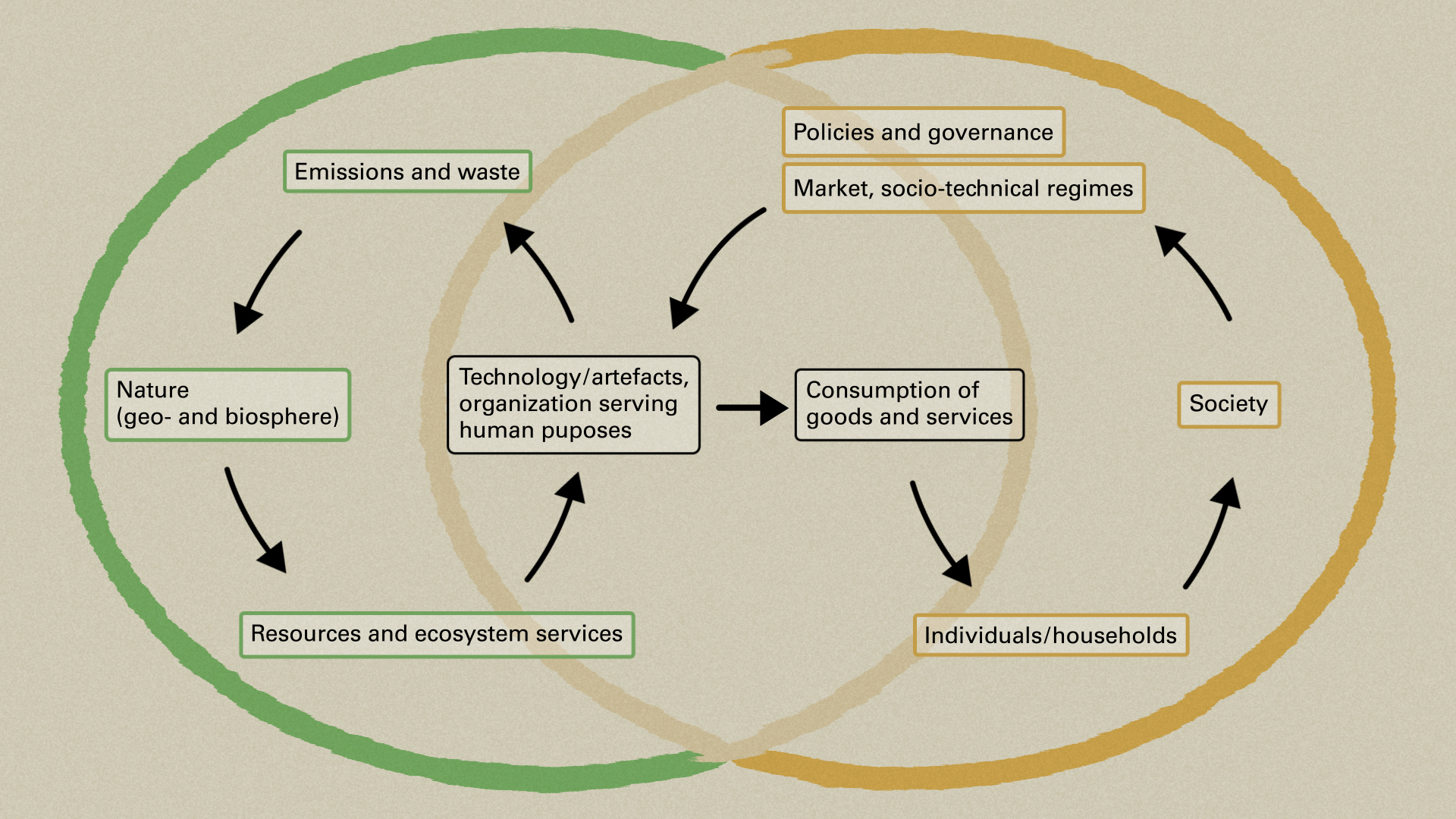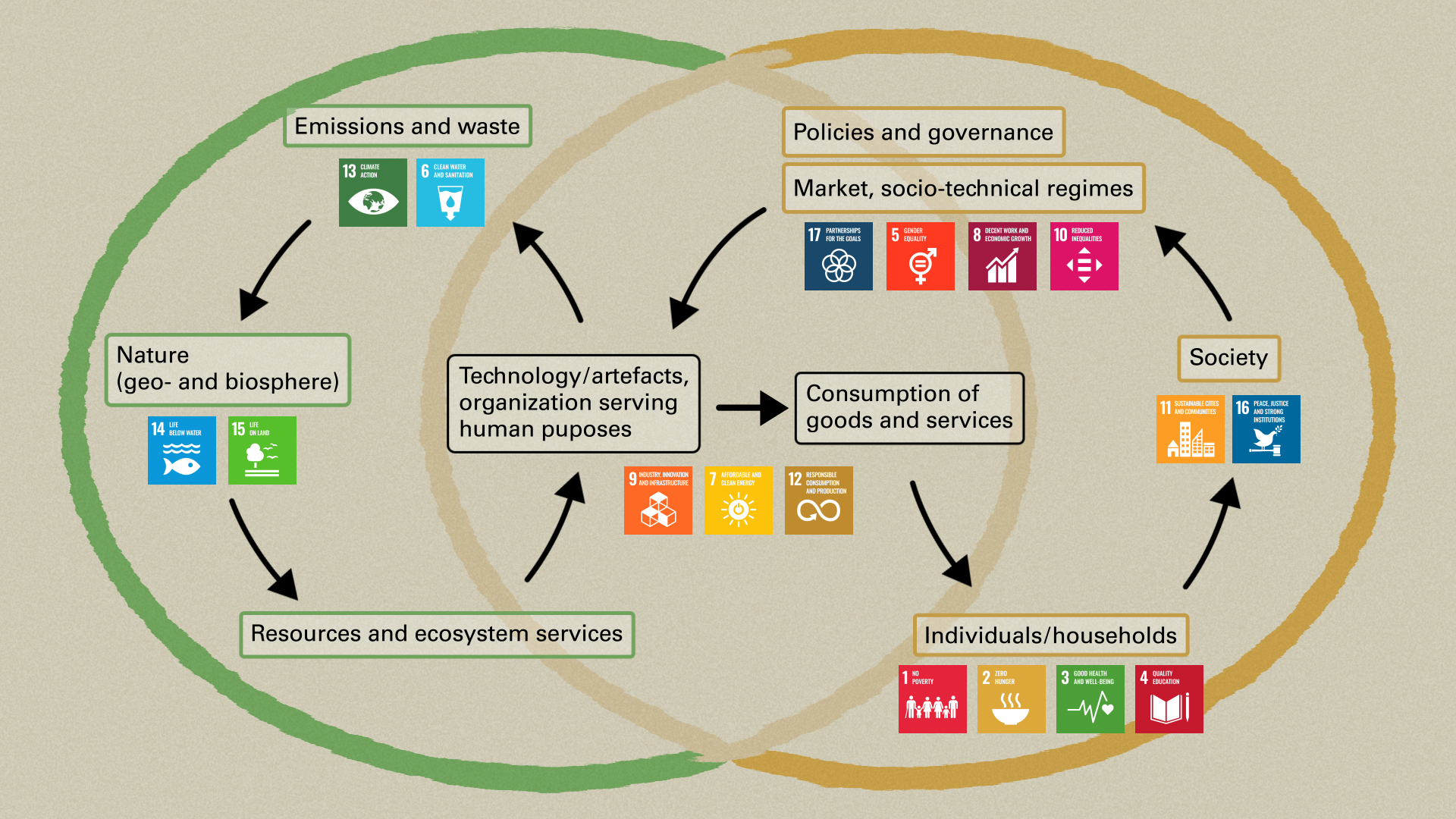UNDERSTANDING THE CONCEPTS OF SUSTAINABILITY
2.6
A basic framework for sustainability
Sustainable development is neither only about the environment nor only about the economy or society, but it is about desirable futures of the global coupled human-nature system.
You explored some of the prevalent scientific conceptions for sustainability. The crucial question is: What has to be sustained?
The approaches that we have presented so far have answered this in specific ways: They focused on resilience, capitals or capability spaces. Accordingly, sustainability is never only about the environment, and never only about the economy or the social sphere.
A general answer to the crucial question lies in the intersection of two spheres: the human and social sphere on the one hand and the environmental sphere on the other. In the tradition of system theory, this is called the (global) coupled human-nature system, as presented in Diagram 1 below.
 Diagram 1: Basic functional components of a coupled human-nature system with its two coupled, but partly independent circles. © Author’s own design; adapted by the New Media Center.
Diagram 1: Basic functional components of a coupled human-nature system with its two coupled, but partly independent circles. © Author’s own design; adapted by the New Media Center.
In this diagram, a dynamic circle on the left, representing nature, overlaps with a dynamic circle on the right, representing the social sphere. There is a strong interaction where the spheres overlap. Here, we use energy and resources to produce goods and services for individual and societal purposes.
Most importantly, the social sphere and the environmental sphere are relatively independent of each other. Although changes in one may lead to changes in the other, this is not always necessarily the case. This is one of the major challenges when it comes to sustainable development.
The idea of sustainability can be interpreted as bringing these circles back into balance. The general answer to the question “What should be sustainable?” is therefore the coupled human-nature system. In this sense, sustainability is more than just bringing in ecological, economic or social criteria for desirable futures.
It would go beyond the scope of this course if we tried to transfer the sustainability concepts outlined earlier to this general diagram. What we can do, however, is to apply the UN Sustainable Development Goals (SDGs) to this diagram.
 Diagram 2: Alignment of the 17 SDGs to the different functional elements to display the goals for the coupled human-nature system. © Author’s own design; adapted by the New Media Center.
Diagram 2: Alignment of the 17 SDGs to the different functional elements to display the goals for the coupled human-nature system. © Author’s own design; adapted by the New Media Center.
The Sustainable Development Goals 1 to 4 (on the right-hand side) relate to the well-being of individuals. They aim at poverty alleviation. SDGs 13, 14, 15 and partly SDG 6 (left) are environment-related. SDGs 7, 9 and 12 (centre) obviously set the conditions for the production of goods and services. Goals 5, 8, 10, 11 and 16 target desirable future societies, with 17 being a global means of implementation.
If we want to move away from the specific approaches – i.e. the capability, capital and resilience approaches – to ask the question “What should be sustainable?”, then it helps to have a more abstract concept like the coupled human-nature system. It allows us to question whether the goals are appropriate – or what might be missing. In addition, because the concept is abstract, we can take different topics (for example, energy or biodiversity) and apply them to the scheme. In this sense, the scheme is a generic one that can be used for different questions concerning sustainability.
Now it is your turn – here is a task for you: Visit the SDG website and select one of the 17 goals. Check to what extent the goals are made operational through targets. Think about possible tensions between the different goals and targets that may require trade-offs.
Author: Paul Burger
